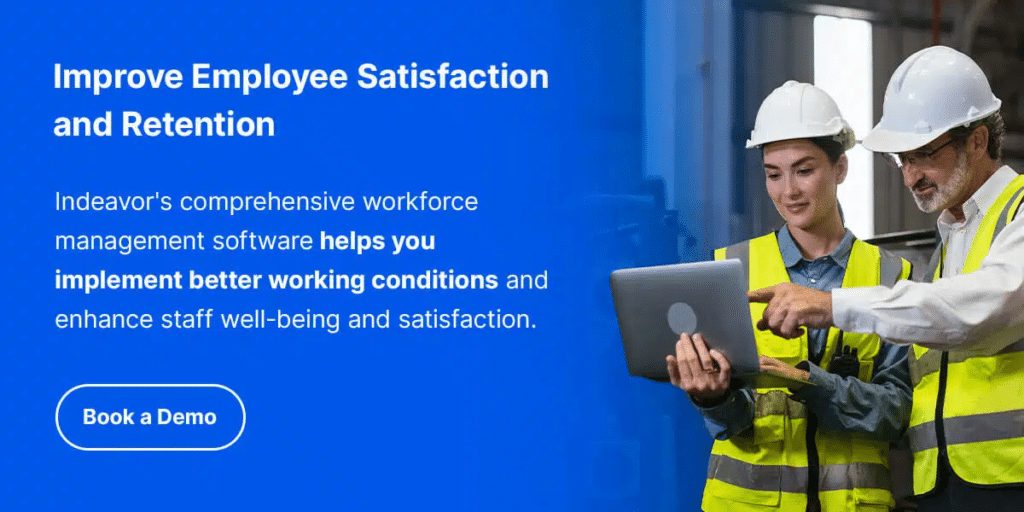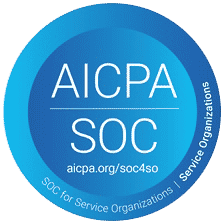Recruiting and retaining skilled employees has become a growing challenge for many industries, especially in manufacturing, where turnover rates have risen from 30.6% in 2017 to 39.9% today. Across all industries, the national turnover rate stands at 47.2%, with the leisure and hospitality sector reaching a staggering 84.9%. High turnover disrupts operations, increases hiring costs, and impacts productivity.
One often overlooked solution for improving recruitment and retention is strategic workforce scheduling. By optimizing schedules, companies can create a more predictable, stable, and employee-friendly work environment, leading to higher job satisfaction, lower turnover, and a more attractive workplace for new hires.
Understanding Recruitment and Retention
Recruitment and retention are two sides of the same coin. Recruitment involves attracting, hiring, and onboarding new employees, while retention focuses on keeping those employees engaged, satisfied, and committed to the company long-term. A strong workforce strategy must address both aspects, as failing to retain employees makes recruitment efforts more costly and inefficient.
What are the goals of recruitment and retention?
The primary goals include:
- Reducing turnover costs by improving employee satisfaction and engagement.
- Building a strong employer brand to attract top talent.
- Enhancing workforce stability through proactive HR strategies.
When employees feel valued and have access to well-structured schedules that support work-life balance, they are more likely to stay with their employer. Companies that succeed in these areas not only improve workforce morale but also gain a competitive edge by reducing hiring costs and increasing productivity.
The Cost of High Turnover and Poor Scheduling
Companies experiencing turnover rates exceeding 30% often face annual replacement costs equaling 25% to 50% of an employee’s salary. Tracking retention KPIs such as turnover rate and average employee tenure provides insight into scheduling-related workforce challenges. These costs include advertising for open positions, onboarding new hires, training, and the lost productivity that occurs while vacancies remain unfilled. Additionally, constant turnover negatively affects team morale, causing further disengagement and leading to even higher attrition rates.
Poor scheduling is a major contributor to turnover. Employees who experience unpredictable hours, excessive overtime, or last-minute shift changes often struggle with stress and burnout. When workers cannot plan their personal lives due to erratic schedules, job dissatisfaction increases, and they are more likely to seek employment elsewhere. In contrast, organizations that implement well-structured workforce scheduling systems reduce these issues, fostering a more stable and committed workforce.

Workforce Scheduling as a Retention Strategy
Strategic scheduling plays a crucial role in employee retention by ensuring that work hours are predictable, fair, and aligned with individual needs. When employees can rely on a stable schedule, they experience lower stress levels and higher job satisfaction, making them less likely to leave their positions.
In addition to stability, flexibility is another key factor in workforce retention. Employees today value work-life balance and seek employers who provide options such as shift-swapping, self-scheduling, and predictable rotations. Companies that offer these benefits create a more appealing work environment, reducing turnover and making recruitment efforts more successful.
Workload balance is another essential consideration. Overworked employees are prone to burnout, which can lead to disengagement and resignations. By using data-driven workforce scheduling, companies can prevent excessive overtime, distribute workloads more evenly, and ensure that employees have adequate rest between shifts.
The Link Between Scheduling and Employee Engagement
Employee engagement is a driving force behind retention. According to a study by The Manufacturing Institute, 83% of employees stay with their current employer because they enjoy their work, while 79% cite job stability and security as primary reasons for remaining. On the other hand, Employees experiencing excessive overtime (more than 20% of their scheduled hours) are twice as likely to leave within a year. Monitoring absenteeism and engagement scores helps HR teams proactively adjust schedules.
Strategic scheduling directly impacts engagement by allowing employees to maintain control over their time. When workers feel empowered through fair scheduling policies, they develop a stronger sense of loyalty to their employer. Additionally, organizations that recognize and accommodate employee preferences create a culture of respect, reinforcing positive engagement and reducing the likelihood of turnover.
A well-structured scheduling system also fosters teamwork and operational efficiency. When employees consistently work alongside the same colleagues, they build stronger relationships and improve collaboration, further enhancing job satisfaction. In contrast, chaotic scheduling that constantly shifts employees between different teams can create confusion and diminish the sense of workplace cohesion.
What are the 3 R’s of employee retention?
- Recruitment: Attracting the right talent with strong scheduling policies.
- Retention: Keeping employees engaged with predictable, fair schedules.
- Recognition: Acknowledging employees’ contributions through thoughtful scheduling and work-life balance.
Companies that use scheduling as an engagement tool experience lower absenteeism, higher morale, and stronger retention rates.
Addressing Recruitment Challenges Through Smart Scheduling
Recruitment efforts become significantly more effective when workforce scheduling is optimized. Candidates today are not just looking for a paycheck; they seek job stability, work-life balance, and an employer that values their time. A well-organized scheduling system becomes a major selling point for potential hires, as it demonstrates that the company prioritizes employee well-being.
One of the biggest recruitment challenges is early turnover, where new hires leave within the first few months due to dissatisfaction with work conditions. Poor scheduling is often a primary factor in these departures. By ensuring that new employees receive structured onboarding schedules and predictable work hours, companies can improve new hire retention and set employees up for long-term success.
Another advantage of strategic scheduling is that it enhances employer branding. Companies known for offering fair and flexible schedules naturally attract more applicants, making it easier to fill open positions with high-quality candidates. A strong reputation in workforce management helps businesses stand out in competitive labor markets, ultimately improving recruitment retention rates.
How scheduling helps recruitment retention efforts
Scheduling plays a key role in recruitment and retention efforts by influencing job seekers’ decisions. Job candidates are more inclined to accept offers from companies that offer structured and predictable scheduling. Once hired, employees are less likely to quit when their schedules align with their personal lives, fostering a sense of balance and satisfaction. A well-organized scheduling system also enhances an employer’s brand, making the company more appealing to top talent.
What Does a Recruitment and Retention Specialist Do?
A recruitment and retention specialist is responsible for developing strategies to attract and keep employees. Their role includes analyzing workforce trends, identifying areas for improvement, and implementing initiatives that enhance job satisfaction. Workforce scheduling is a crucial part of their work, as it directly affects employee retention.
By collaborating with HR and operations teams, these specialists ensure that scheduling aligns with employee needs while maintaining business efficiency. They also use workforce data to identify potential turnover risks, allowing companies to take proactive measures before attrition becomes a larger issue. When scheduling is managed strategically, recruitment and retention specialists can create a work environment that encourages long-term commitment.
The Four Pillars of Retention and Scheduling’s Role
Retaining employees requires more than just offering competitive salaries—it demands a holistic approach that considers how workplace policies impact overall job satisfaction. While compensation is a key factor, employees are more likely to stay when they feel they have opportunities for growth, work in a supportive environment, and can maintain a healthy work-life balance.
Workforce scheduling plays a critical role in each of these areas, influencing how employees perceive stability, fairness, and their long-term future with a company. By aligning scheduling strategies with these four pillars of retention, businesses can create a more engaged and committed workforce.
What are the 4 pillars of retention?
- Compensation & Benefits: Employees expect fair wages and benefits, but scheduling also plays a role in perceived compensation. Predictable work hours and access to paid time off contribute to financial stability and job satisfaction, ensuring employees feel fairly compensated beyond just their paycheck.
- Career Growth: Scheduling impacts an employee’s ability to participate in training programs, take on leadership roles, and pursue internal promotions. A well-structured schedule provides opportunities for career advancement, showing employees that the company invests in their long-term success.
- Work Environment: A balanced schedule reduces workplace stress, minimizes scheduling conflicts, and prevents staffing shortages that overburden employees. When shifts are distributed fairly, team morale improves, fostering a more positive and productive workplace culture.
- Work-Life Balance: Flexible scheduling options help employees manage personal responsibilities while maintaining their professional commitments. Providing shift-swapping options, self-scheduling tools, or stable hours reduces burnout and enhances overall job satisfaction.
When companies integrate workforce scheduling into retention strategies, they create an environment where employees feel valued, engaged, and motivated to stay.

Leveraging Data-Driven Scheduling for Retention Success
To improve recruitment and retention, companies must harness workforce data to make smarter scheduling decisions. Tracking employee retention KPIs allows organizations to analyze turnover trends, measure engagement, and understand how scheduling impacts workforce stability. Companies that track shift volatility (the frequency of last-minute schedule changes) notice a 20% improvement in retention rates after optimizing schedules with data-driven tools. Without these insights, businesses risk losing employees to poor scheduling practices such as excessive overtime, uneven shift distribution, and last-minute changes—all of which contribute to dissatisfaction and attrition.
Real-time workforce analytics provide a proactive approach to identifying and resolving scheduling inefficiencies. By pinpointing trends like frequent absenteeism in certain shifts or departments, organizations can make informed adjustments that enhance job satisfaction. Additionally, predictive scheduling tools help managers anticipate staffing needs, ensuring that employees receive fair workloads and reducing the likelihood of disruptive last-minute schedule changes.
Companies that invest in automated workforce scheduling solutions gain a competitive advantage by fostering a stable and engaged workforce. These systems create equitable, data-driven schedules that align business demands with employee preferences, leading to higher retention rates. With features like self-service scheduling, AI-driven shift recommendations, and real-time labor tracking, businesses can provide employees with greater flexibility and control over their schedules—key factors in reducing turnover.
How Workforce Scheduling Data Improves Retention
Workforce scheduling data plays a crucial role in retention success by offering insights that help refine scheduling strategies:
- Retention KPIs highlight scheduling-related turnover trends, allowing companies to address problem areas before they escalate.
- Real-time workforce analytics pinpoint issues such as high absenteeism in specific shifts, helping managers adjust schedules to prevent burnout.
- Predictive scheduling tools ensure that overstaffing and understaffing are minimized, fostering a more balanced and productive work environment.
How Scheduling Technology Helps Recruitment Retention
The right workforce scheduling technology supports both recruitment and retention by improving the employee experience:
- AI-driven shift optimization promotes fairness by distributing shifts equitably.
- Self-service scheduling options give employees more autonomy, enhancing work-life balance.
- Real-time labor tracking helps businesses avoid last-minute schedule changes that create stress and dissatisfaction.
Tools that provide predictable and fair shifts and real-time labor tracking create a more attractive workplace for workers. By leveraging data-driven scheduling, companies can reduce turnover and improve employee satisfaction.
The Future of Recruitment and Retention with Smart Scheduling
As workforce dynamics continue to evolve, companies must adapt their recruitment and retention strategies to remain competitive. High turnover rates and recruitment challenges will persist for businesses that fail to prioritize fair scheduling practices. However, organizations that implement strategic workforce scheduling will experience improved employee satisfaction, reduced turnover costs, and a stronger employer brand.
By investing in scheduling solutions that offer stability, flexibility, and data-driven insights, companies can create a work environment that attracts top talent and encourages long-term commitment. Workforce scheduling is no longer just a logistical necessity—it is a powerful tool for enhancing recruitment retention and building a thriving, engaged workforce.
About the Author
Claire Pieper is the Digital Marketing Specialist for Indeavor. In her role, she specializes in crafting strategic and engaging content, ensuring that customers are well-informed. Claire is dedicated to enhancing the customer experience and optimizing the user journey through Indeavor’s solutions. To learn more or get in touch, connect with Claire on LinkedIn.







